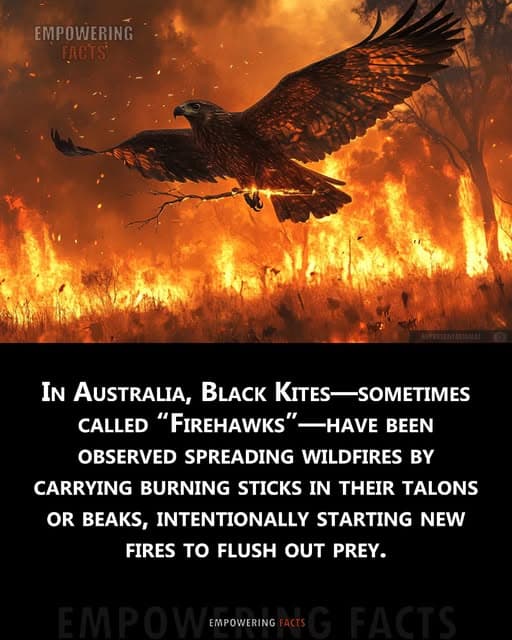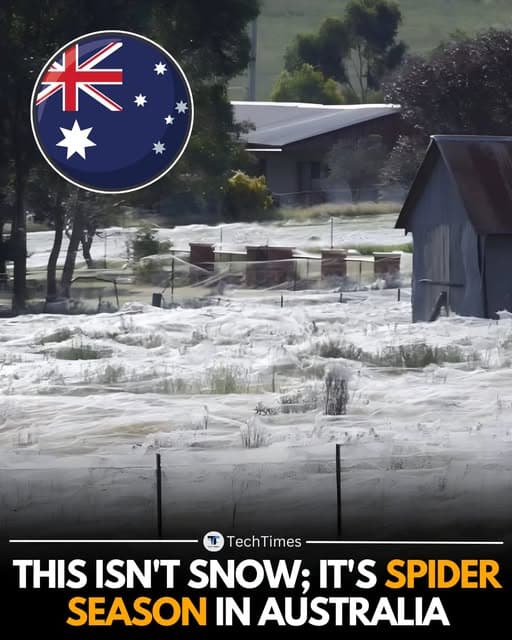There are many reasons why it is difficult to prevent fires eh…
Black Kites (Milvus migrans), along with other raptors like Whistling Kites and Brown Falcons, have been documented exhibiting fire-spreading behavior in parts of northern Australia. Indigenous fire managers and field researchers have reported that these birds pick up smoldering sticks from active bushfires and drop them into dry grassland or scrub areas not yet burning. This behavior appears to be a hunting strategy, designed to flush small animals like rodents, insects, and reptiles out of hiding.
The phenomenon, though not widespread globally, has been recognized through field observations and oral histories from Aboriginal communities, particularly among fire-savvy groups in the Northern Territory. These accounts were later supported by ecological studies published in peer-reviewed journals, which detail coordinated behavior among raptors during fire events.
The birds often wait near fire lines and take advantage of prey attempting to escape. By extending the fire’s reach with smoldering twigs, they effectively expand their hunting zone. While the action seems deliberate, scientists are still cautious about defining the behavior strictly as tool use, though it aligns closely with some definitions of it in animal cognition research.
This behavior is one of the few known examples of animals manipulating fire in the wild, and it has drawn international attention for its implications in both ecology and the study of animal intelligence. 

#AnimalBehavior #Firehawks #AustralianWildlife
3 Likes
You never need to get caught short in Australia…
It seems I’m a couple of months behind the news, but if you are like me, you may not have heard that Nine is working with Optus to take over the EPL TV rights in Aus to be broadcast on Stan Sport.. This for me is fantastic news if we can receive both the CL and EPL from the same service. The big bonus is that we might finally get EPL in something higher than 720p. Maybe 4k like the CL.
Don’t think it’ll happen like that. Nine dont have any football rights and are likely, if anything, to charge more for the same service. Also Optus currently offer 1080p and don’t know if Nine would invest to move that to 4k.
Sorry, I edited my post. Should have said it was for Nine’s Stan Sports service.
Yeah it would be nice to have the CL and PL back in the one sub and could justify a price rise.
Fingers crossed NSW people 
I love how the media and weather experts have just created the term Bomb Cyclone to scare the shit out of everyone. It rained.
Well the term is also used by more reputable media as it follows a BOM definition:
When a low-pressure system transforms from non-existence to a formidable storm just a day later, meteorologists label it a “bomb cyclone”, or a system that has experienced “bombogenesis”.
The expression “bomb” is due to the explosive speed of development, however its usage is restricted only to systems where the reduction in pressure exceeds a specific rate based on latitude.
For the Tasman Sea, the drop in central pressure required in a 24-hour period ranges from 18hectopascals (hPa) near Tasmania to 14hPa near the Queensland-NSW border.
Next week’s low is predicted by modelling to deepen between 22hPa and 24hPa in a day — easily passing the weather bomb criteria.
Considering the above definition is based solely on pressure, the nonsensical term “rain bomb” becomes an irrational fallacy, lacking any scientific validity.
Lets face it when your official weather bureau has (until very recently) called itself ‘the BOM’, it’s no surprise that they would shoe-horn ‘bomb’ into any extreme weather phenomenon they could.
1 Like
Reputable media - that’s almost as much of a hoax term as using Bomb to describe weather.
Im getting more cynical as I get older…..anyway the storm has passed here.
Don’t go down the tinfoil hat route. There are reputable media and, provided you are conscious of any subject biases and cross check as appropriate, then you absolutely can rely upon them. The idea that ‘they are all the same’ and ‘you can’t trust anyone’ is what the far right want you to believe as it is designed to erode any sense of society and leave us only with the strong preying on the weak without regulation or oversight.
3 Likes
I don’t think I’ve watched a single news report from the advert stations(7,9,10) or about 20 years. Its not so much that they don’t align with my political views, but that from my recollections it was mostly rubbish, Americanized, sensationalized news reporting, whereas I watch the news to find out what is actually going on in the world. Australia is always in its own bubble so I want to peer outside that and occasionally thats what ABC or SBS supply. Sure, you need to realise that ABC is always ‘backing their Labor boys’, but if you go in with that knowledge, then its easier to spot that.
Don’t think that is fair. They are actually quite right of centre on a host of issues and their support for Israel is borderline fascist.
1 Like
Sounds like that aligns pretty closely to Labor then? 
And liberal. But you are right not the greens.
1 Like
Every year during late summer or early autumn, parts of Australia get blanketed in ghostly white sheets… not from snow, but from millions of spiders! This bizarre event is called mass ballooning, where spiders release silk threads that catch the wind and carry them across vast distances. When thousands do it at once, the silk coats the ground, fences, and buildings — turning the entire landscape into something out of a sci-fi film.
It may look eerie, but it’s completely natural and harmless. It’s one of nature’s strangest migrations — and one of Australia’s wildest seasonal spectacles.
3 Likes
Happens elsewhere too; just read Charlotte’s Web.
Really only need to worry about RedBacks, Sydney Funnel Webs and Mouse spiders. The rest will only draw blood (wolf spider) or give you a nasty infected bump that lasts a few weeks (White Tail).

1 Like
Amazing the way this club has impacted the lives of people..
“My daughter, a massive LFC fan is doing it tough. Her motivation right now is to stand in the Kop sing YNWA and watch her heroes play.”
3 Likes
![]()
![]()




